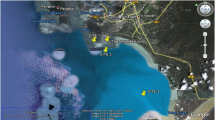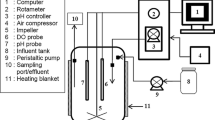Abstract
To use microalgae for the biosequestration of carbon dioxide (CO2) emitted from the coal-fired power plants, the screening of high CO2 tolerant microalgae and their accumulation of toxic agents have attracted significant research attention. This study evaluated 10 Chlorella strains for high CO2 tolerance using combined growth rates and growth periods subjected to logistic parameters. We selected LAMB 31 with high r (0.89 ± 0.10 day−1), high k (6.51 ± 0.19), and medium Tp (5.17 ± 0.15 day) as a candidate for CO2 biosequestration. Correspondingly, six genes involving carbon fixation and metabolism processes were upregulated in LAMB 31 under high CO2 conditions, verifying its high CO2 tolerant ability. LAMB 31 cultures exposed to exhaust gas of power plant under different flow rates grew well, but the high flow rate (0.6 L/h) showed inhibition effects compared with low flow rates (0.2 and 0.3 L/h) at the end of the culturing period. The toxic agents in the exhaust gas including sulfur, arsenic, and mercury accumulated in LAMB 31 biomass but were deemed safe for use in the production of both human food and animal feed based on the National Food Safety Standard in China. This study showed a complete process involving high CO2 tolerant microalgae screening, high CO2 tolerant verification, and in situ application in a power plant. Data results provide valuable information as the basis for future research studies in microalgae application on CO2 mitigation at emission sources.




Similar content being viewed by others
Data Availability
All data generated or analyzed during this study are included in this published article.
References
Behera B, Aly N, Balasubramanian P (2019) Biophysical model and techno-economic assessment of carbon sequestration by microalgal ponds in Indian coal-based power plants. J Clean Prod 221:587–597
Cheng D, Li X, Yuan Y, Yang C, Tang T, Zhao Q, Sun Y (2019) Adaptive evolution and carbon dioxide fixation of Chlorella sp. in simulated flue gas. Sci Total Environ 650:2931–2938
Chioccioli M, Hankamer B, Ross IL (2014) Flow cytometry pulse with data enables rapid and sensitive estimation of biomass dry weight in the microalgae Chlamydomonas reinhardtii and Chlorella vulgaris. PLoS One 9:e97296
Chiu SY, Kao CY, Chen CH, Kuan TC, Lin CS (2008) Reduction of CO2 by a high-density culture of Chlorella sp. in a semicontinuous photobioreactor. Bioresour Technol 99:3389–3396
Deviram G, Mathiani T, Anto S, Ahamed TS, Ananth DA, Pugazhendhi A (2020) Applications of microalgal and cyanobacterial biomass on a way to safe, cleaner and a sustainable environment. J Clean Prod 253:119770
Duarte JH, Fanka LS, Costa JAV (2016) Utilization of simulated flue gas containing CO2, SO2, NO and ash for Chlorella fusca cultivation. Bioresour Technol 214:159–165
Gaidarenko O, Sathoff C, Staub K, Huesemann MH, Vernet M, Hildebrand M (2019) Timing is everything: diel metabolic and physiological changes in the diatom Cyclotella cryptica grown in simulated outdoor conditions. Algal Res 42:101598
Ghosh A, Kiran B (2017) Carbon concentration in algae: reducing CO2 from exhaust gas. Trends Biotechnol 35:806–808
Greenwell HC, Laurens LML, Shields RJ, Lovitt RW, Flynn KJ (2010) Placing microalgae on the biofuels priority list: a review of the technological challenges. J R Soc Interface 7:703–726
Hashemipetroudi SH, Nematzadeh G, Ahmadian G, Yamchi A, Kuhlmann M (2018) Assessment of DNA contamination in RNA samples based on ribosomal DNA. J Vis Exp 131:55451
Ho SH, Chen WM, Chang JS (2010) Scenedesmus obliquus CNW-N as a potential candidate for CO2 mitigation and biodiesel production. Bioresour Technol 101:8725–8730
Huang Y, Cheng J, Lu HX, He Y, Zhou JH, Cen KF (2017) Transcriptome and key genes expression related to carbon fixation pathways in Chlorella PY-ZU1 cells and their growth under high concentrations of CO2. Biotechnol Biofuels 10:181
Iwamoto H (2007) Industrial production of microalgal cell-mass and secondary products-major industrial species: Chlorella. In: Richmond A (ed) Handbook of microalgal culture: biotechnology and applied phycology. Blackwell Science, Morton, pp 253–263
Iwasaki I (1996) Effects of high-CO2 stress on photosystem II in a green alga, Chlorococcum littorale, which has a tolerance to high CO2. J Photochem Photobiol B Biol 36:327–332
Kao CY, Chen TY, Chang YB, Chiu TW, Lin HY, Chen CD, Chang JS, Lin CS (2014) Utilization of carbon dioxide in industrial flue gases for the cultivation of microalga Chlorella sp. Bioresour Technol 166:485–493
Kuo CM, Jian JF, Lin TH, Chang YB, Wan XH, Lai JT, Chang JS, Lin C (2016) Simultaneous microalgal biomass production and CO2 fixation by cultivating Chlorella sp. GD with aquaculture wastewater and boiler flue gas. Bioresour Technol 221:241–250
Li DJ, Wang L, Zhao QY, Wei W, Sun YH (2015) Improving high carbon dioxide tolerance and carbon dioxide fixation capability of Chlorella sp. by adaptive laboratory evolution. Bioresour Technol 185:269–275
Li J, Tang XX, Pan KH, Zhu BH, Zhao Y (2020) The regulating mechanisms of CO2 fixation and carbon allocations of two Chlorella sp. strains in response to high CO2 levels. Chemosphere 247:125814
Liu J, Chen F (2016) Biology and industrial applications of Chlorella: advances and prospects. Adv Biochem Eng Biotechnol 153:1–35
Maity JP, Bundschuh J, Chen CY, Bhattacharya P (2014) Microalgae for third generation biofuel production, mitigation of greenhouse gas emissions and wastewater treatment: present and future perspectives-a mini review. Energy 78:104–113
Marti-Quijal FJ, Zamuz S, Tomašević L, Gomez B, Rocchetti G, Lucini L, Remize F, Barba FJ, Lorenzeo JM (2019a) Influence of different sources of vegetable, whey and microalgae proteins on the physicochemical properties and amino acid profile of fresh pork sausages. LWT 110:316–323
Marti-Quijal FJ, Zamuz S, Tomašević I, Rocchetti G, Lucini L, Marszalek K, Barba FJ, Lorenzo JM (2019b) A chemometric approach to evaluate the impact of pulses, Chlorella and Spirulina on proximate composition, amino acid, and physicochemical properties of turkey burgers. J Sci Food Agric 99:3672–3680
Medeiros VPBD, Pimentel TC, Sant'Ana AS, Magnani M (2021) Microalgae in the meat processing chain: feed for animal production or source of techno-functional ingredients. Curr Opin Food Sci 37:125–134
Morais MGD, Costa JAV (2007) Isolation and selection of microalgae from coal fired thermoelectric power plant for biofixation of carbon dioxide. Energ Convers Manage 48:2169–2173
Napan K, Teng L, Quinn JC, Wood BD (2015) Impact of heavy metals from flue gas integration with microalgae production. Algal Res 8:83–88
Napan K, Kumarasamy K, Quinn JC, Wood BD (2016) Contamination levels in biomass and spent media from algal cultivation system contaminated with heavy metals. Algal Res 19:39–47
Negoro M, Shioji N, Miyamoto K, Micira Y (1991) Growth of microalgae in high CO2 gas and effects of SOx and NOx. Appl Biochem Biotechnol 28-29:877–886
Otromke M, Shuttleworth PS, Sauer J, White RJ (2019) Hydrothermal base catalysed treatment of kraft lignin for the preparation of a sustainable carbon fibre precursor. Bioresour Technol Rep 5:251–260
Patania F, Gagliano A, Nocera F (2014) Galesi A. Ecology and the environment, Berlin
Pulz O, Gross W (2004) Valuable products from biotechnology of microalgae. Appl Microbiol Biotechnol 65:635–648
Raven JA (2010) Inorganic carbon acquisition by eukaryotic algae: four current questions. Photosynth Res 106:123–134
Raya I, Anshar AM, Mayasari E, Dwiyana Z, Asdar M (2016) Chorella vulgaris and Spirulina platensis: concentration of protein, docosahexaenoic acid Chorella (DHA), eicosapentaenoic acid (EPA) and variation concentration of maltodextrin via microencapsulation method. Int J Appl Chem 12:539–548
Roach T, Na CS, Krieger-Liszkay A (2015) High light-induced hydrogen peroxide production in Chlamydomonas reinhardtii is increased by high CO2 availability. Plant J 81:759–766
Rocca NL, Andreoli C, Giacometti G, Rascio N, Moro I (2009) Responses of the Antarctic microalga Koliella antarctica (Trebouxiophyceae, Chlorophyta) to cadmium contamination. Photosynthetica 47:471–479
Shuba ES, Kifle D (2018) Microalgae to biofuels: ‘promising’ alternative and renewable energy, review. Renew Sust Energ Rev 81:743–755
Singh SK, Sundaram S, Kishor K (2014) Photosynthetic microorganisms. WIT press, Berlin
Solovchenko A, Khozin-Goldberg I (2013) High-CO2 tolerance in microalgae: possible mechanisms and implications for biotechnology and bioremediation. Biotechnol Lett 35:1745–1752
Surendhiran D, Vijay M, Sivaprakash B, Sirajunnisa A (2015) Kinetic modeling of microalgal growth and lipid synthesis for biodiesel production. 3. Biotech 5:663–669
Tang D, Han W, Li P, Miao X, Zhong J (2011) CO2 biofixation and fatty acid composition of Scenedesmus obliquus and Chlorella pyrenoidosa in response to different CO2 levels. Bioresour Technol 102:3071–3076
Tyler AJ, Jasdeep SK, Michale TH, Rudolf KB, Keith CM, William EF (2019) Direct human health risks of increased atmospheric carbon dioxide. Nat Sustain 2:691–701
Valdovinos-García EM, Barajas-Fernández J, Olán-Acosta MDLA, Petriz-Prieto MA, Guzmán-López A, Bravo-Sánchez MG (2020) Techno-economic study of CO2 capture of a thermoelectric plant using microalgae (Chlorella vulgaris) for production of feedstock for bioenergy. Energies 13:413
Wei L, Shen C, El Hajjami M, You W, Wang Q, Zhang P, Ji Y, Hu H, Hu Q, Poetsch A, Xu J (2019) Knockdown of carbonate anhydrase elevates Nannochloropsis productivity at high CO2 level. Metab Eng 54:96–108
Yen HW, Chen PW, Chen LJ (2015a) The synergistic effects for the co-cultivation of oleaginous yeast-Rhodotorula glutinis and microalgae-Scenedesmus obliquus on the biomass and total lipids accumulation. Bioresour Technol 184:148–152
Yen HW, Ho SH, Chen CY, Chang JS (2015b) CO2, NOx and SOx removal from flue gas via microalgae cultivation: a critical review. Biotechnol J 10:829–839
Zhao Y, Wang Y, Quigg A (2015) Comparison of population growth and photosynthetic apparatus changes in response to different nutrient status in a diatom and a coccolithophore. J Phycol 51:872–884
Zhao YR, Tang XX, Quigg A, Lv MC, Zhao Y (2019) The toxic mechanisms of BDE-47 to the marine diatom Thalassiosira pseudonana-a study based on multiple physiological processes. Aquat Toxicol 212:20–27
Zhu BH, Sun FQ, Yang M, Lu L, Yang GP, Pan KH (2014) Large-scale biodiesel production using flue gas from coal-fired power plants with Nannochloropsis microalgal biomass in open raceway ponds. Bioresour Technol 174:53–59
Žugčić T, Abdelkebir R, Barba FJ, Rezek-Jambrak A, Gálvez F, Zamuz S, Granato D, Lorenzo JM (2018) Effects of pulses and microalgal proteins on quality traits of beef patties. J Food Sci Technol 55:4544–4553
Acknowledgements
We gratefully acknowledge the kind assistance of Qianqian Zhao in measuring the OD values.
Funding
This research work was financially supported by the National Key Research and Development Program of China (No. 2016YFB0601001) and the National Natural Science Foundation of China (No. 41706124).
Author information
Authors and Affiliations
Contributions
Yan Zhao: Writing — review and editing, supervision, conceptualization, and funding acquisition. Jun Li: data curation, roles/writing — original draft, validation, and methodology. Xuebin Ma: formal analysis and software. Xingyu Fang: software. Baohua Zhu: supervision. Kehou Pan: project administration, funding acquisition, conceptualization, and supervision.
Corresponding authors
Ethics declarations
Ethics approval and consent to participate
Not applicable.
Consent for publication
Not applicable.
Competing interests
The authors declare no competing interests.
Additional information
Responsible Editor: Philippe Garrigues
Publisher’s note
Springer Nature remains neutral with regard to jurisdictional claims in published maps and institutional affiliations.
Supplementary Information
ESM 1
(DOCX 18 kb)
Rights and permissions
About this article
Cite this article
Zhao, ., Li, J., Ma, X. et al. Screening and application of Chlorella strains on biosequestration of the power plant exhaust gas evolutions of biomass growth and accumulation of toxic agents. Environ Sci Pollut Res 29, 6744–6754 (2022). https://doi.org/10.1007/s11356-021-15950-8
Received:
Accepted:
Published:
Issue Date:
DOI: https://doi.org/10.1007/s11356-021-15950-8




